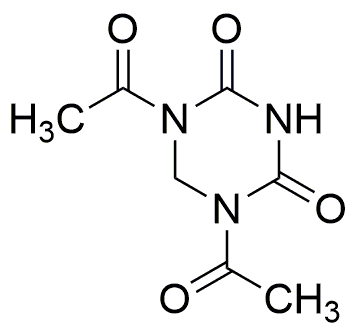1,5-Diacetyl-1,3,5-triazinane-2,4-dione is widely utilized in research focused on:
- Pharmaceutical Development: This compound serves as an important intermediate in synthesizing various pharmaceuticals, particularly in the development of anti-inflammatory and analgesic drugs.
- Agricultural Chemicals: It is used in formulating agrochemicals, enhancing crop protection products by improving their efficacy and stability.
- Polymer Science: The compound is applied in creating specialty polymers, offering improved thermal and mechanical properties compared to traditional materials.
- Analytical Chemistry: It acts as a reagent in analytical methods, aiding in the detection and quantification of other chemical substances in complex mixtures.
- Food Industry: This chemical is explored for its potential as a food additive, providing flavor enhancement and preservation benefits.
General Information
Properties
Safety and Regulations
Applications
1,5-Diacetyl-1,3,5-triazinane-2,4-dione is widely utilized in research focused on:
- Pharmaceutical Development: This compound serves as an important intermediate in synthesizing various pharmaceuticals, particularly in the development of anti-inflammatory and analgesic drugs.
- Agricultural Chemicals: It is used in formulating agrochemicals, enhancing crop protection products by improving their efficacy and stability.
- Polymer Science: The compound is applied in creating specialty polymers, offering improved thermal and mechanical properties compared to traditional materials.
- Analytical Chemistry: It acts as a reagent in analytical methods, aiding in the detection and quantification of other chemical substances in complex mixtures.
- Food Industry: This chemical is explored for its potential as a food additive, providing flavor enhancement and preservation benefits.
Documents
Safety Data Sheets (SDS)
The SDS provides comprehensive safety information on handling, storage, and disposal of the product.
Product Specification (PS)
The PS provides a comprehensive breakdown of the product’s properties, including chemical composition, physical state, purity, and storage requirements. It also details acceptable quality ranges and the product's intended applications.
Certificates of Analysis (COA)
Search for Certificates of Analysis (COA) by entering the products Lot Number. Lot and Batch Numbers can be found on a product’s label following the words ‘Lot’ or ‘Batch’.
*Catalog Number
*Lot Number
Certificates Of Origin (COO)
This COO confirms the country where the product was manufactured, and also details the materials and components used in it and whether it is derived from natural, synthetic, or other specific sources. This certificate may be required for customs, trade, and regulatory compliance.
*Catalog Number
*Lot Number
Safety Data Sheets (SDS)
The SDS provides comprehensive safety information on handling, storage, and disposal of the product.
DownloadProduct Specification (PS)
The PS provides a comprehensive breakdown of the product’s properties, including chemical composition, physical state, purity, and storage requirements. It also details acceptable quality ranges and the product's intended applications.
DownloadCertificates of Analysis (COA)
Search for Certificates of Analysis (COA) by entering the products Lot Number. Lot and Batch Numbers can be found on a product’s label following the words ‘Lot’ or ‘Batch’.
*Catalog Number
*Lot Number
Certificates Of Origin (COO)
This COO confirms the country where the product was manufactured, and also details the materials and components used in it and whether it is derived from natural, synthetic, or other specific sources. This certificate may be required for customs, trade, and regulatory compliance.


